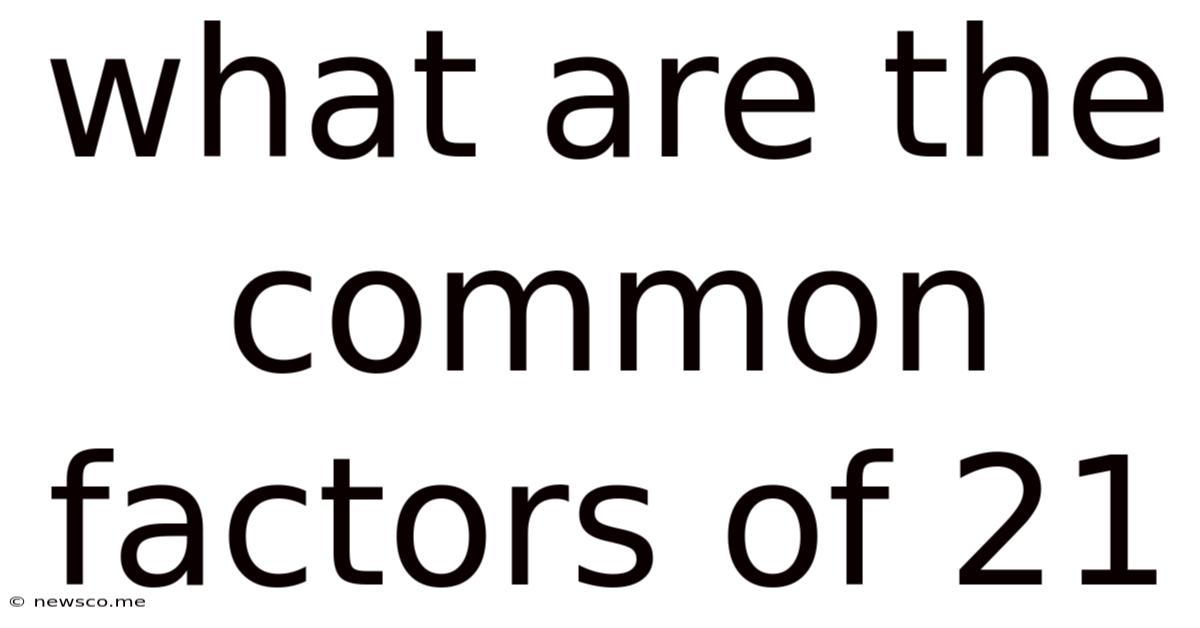What Are The Common Factors Of 21
News Co
Apr 11, 2025 · 4 min read

Table of Contents
What Are the Common Factors of 21? Unraveling the Basics of Number Theory
Finding the common factors of a number might seem like a simple task, especially for a smaller number like 21. However, understanding this concept lays the foundation for more complex mathematical concepts, and a grasp of it is crucial for various applications, from cryptography to computer science. This comprehensive guide will delve into the common factors of 21, exploring the underlying principles and expanding on the broader context of number theory.
Understanding Factors
Before we pinpoint the factors of 21, let's establish a clear definition. A factor (or divisor) of a number is a whole number that divides the number exactly, leaving no remainder. In other words, if 'a' is a factor of 'b', then b/a results in a whole number.
For example, the factors of 12 are 1, 2, 3, 4, 6, and 12 because each of these numbers divides 12 without leaving a remainder.
Identifying the Factors of 21
Now, let's focus on the number 21. To find its factors, we need to identify all the whole numbers that divide 21 evenly. We can approach this systematically:
- 1: 21 divided by 1 equals 21 (no remainder).
- 3: 21 divided by 3 equals 7 (no remainder).
- 7: 21 divided by 7 equals 3 (no remainder).
- 21: 21 divided by 21 equals 1 (no remainder).
Therefore, the factors of 21 are 1, 3, 7, and 21.
Prime Factorization and its Significance
The concept of prime factorization is essential in number theory. A prime number is a whole number greater than 1 that has only two factors: 1 and itself. Prime factorization involves expressing a number as a product of its prime factors.
Let's apply this to 21:
21 can be expressed as 3 x 7. Both 3 and 7 are prime numbers. This is the prime factorization of 21. Understanding the prime factorization of a number allows us to easily determine all its factors. Any combination of the prime factors (including raising them to powers if there are repeated factors) will result in a factor.
Common Factors and Greatest Common Factor (GCF)
When considering multiple numbers, we often need to identify their common factors. These are the factors that are shared by all the numbers in question. Let's consider the numbers 21 and another number, say 42.
The factors of 42 are 1, 2, 3, 6, 7, 14, 21, and 42.
Comparing the factors of 21 (1, 3, 7, 21) and the factors of 42 (1, 2, 3, 6, 7, 14, 21, 42), we find that the common factors are 1, 3, 7, and 21.
The greatest common factor (GCF), also known as the highest common factor (HCF), is the largest of these common factors. In this case, the GCF of 21 and 42 is 21.
Applications of Common Factors and GCF
The concept of common factors and GCF has far-reaching applications across various fields:
-
Simplifying Fractions: Finding the GCF of the numerator and denominator allows us to simplify fractions to their lowest terms. For example, the fraction 42/21 can be simplified to 2/1 (or simply 2) by dividing both the numerator and denominator by their GCF (21).
-
Solving Equations: In algebra, understanding common factors helps in factoring expressions and solving equations.
-
Geometry: GCF is used in geometry problems involving finding the dimensions of shapes that can be tiled perfectly using smaller squares or other shapes.
-
Computer Science: Algorithms in computer science rely on concepts of factors and GCF for tasks like optimizing data structures and algorithms.
-
Cryptography: Number theory and its related concepts like prime factorization and GCF play a crucial role in modern cryptography, forming the backbone of many encryption techniques.
Exploring Further: Least Common Multiple (LCM)
Closely related to the GCF is the least common multiple (LCM). While the GCF is the largest number that divides both numbers, the LCM is the smallest number that is a multiple of both numbers. For example, the LCM of 21 and 42 is 42.
Finding the LCM and GCF is often necessary in solving problems involving fractions and ratios.
Advanced Concepts: Euclidean Algorithm
The Euclidean algorithm is an efficient method for calculating the GCF of two numbers. This ancient algorithm avoids the need to list out all the factors of each number, making it particularly useful for larger numbers where finding all factors can be time-consuming. The algorithm involves repeatedly applying the division algorithm until the remainder is zero. The last non-zero remainder is the GCF.
Conclusion: The Importance of Foundational Mathematical Concepts
Understanding the common factors of a number, like 21 in this case, provides a solid foundation for more advanced mathematical concepts. The seemingly simple task of identifying factors extends to crucial applications in various fields, highlighting the importance of fundamental mathematical principles in our daily lives and technological advancements. Whether it's simplifying fractions, solving algebraic equations, or contributing to the security of our digital world, the concept of factors remains a cornerstone of mathematics and its broader applications. This detailed exploration of the factors of 21 provides a starting point for those wishing to delve deeper into the fascinating world of number theory. By understanding these fundamental concepts, we unlock a greater appreciation for the elegance and power of mathematics.
Latest Posts
Related Post
Thank you for visiting our website which covers about What Are The Common Factors Of 21 . We hope the information provided has been useful to you. Feel free to contact us if you have any questions or need further assistance. See you next time and don't miss to bookmark.